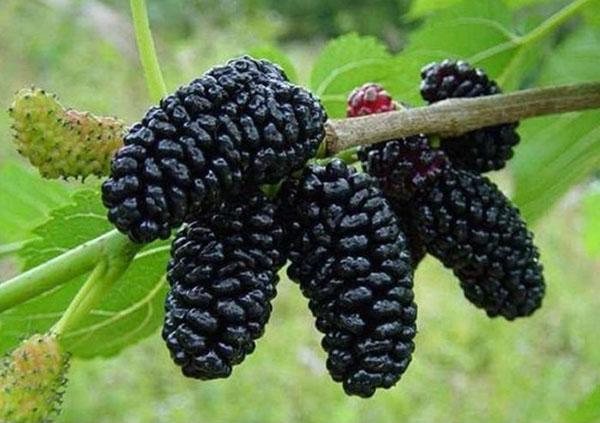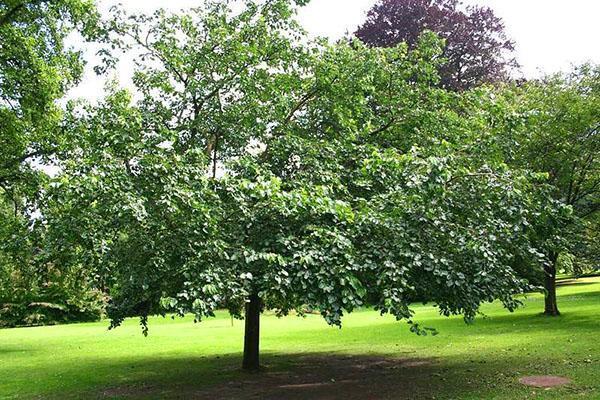A living treasure of useful elements - a mulberry tree
 To lead a fulfilling life, a person needs to constantly replenish his vitamin supply, especially in the summer. The mulberry tree is a unique treasure of useful elements necessary for the body. Plants from this mysterious family can be found almost all over the earth. They come in the form of shrubs, trees, lianas and only occasionally grasses. The main feature of the "Mulberry" family is the ability to secrete a liquid very similar to milk. These include more than 1,500 species that prefer a relatively warm climate.
To lead a fulfilling life, a person needs to constantly replenish his vitamin supply, especially in the summer. The mulberry tree is a unique treasure of useful elements necessary for the body. Plants from this mysterious family can be found almost all over the earth. They come in the form of shrubs, trees, lianas and only occasionally grasses. The main feature of the "Mulberry" family is the ability to secrete a liquid very similar to milk. These include more than 1,500 species that prefer a relatively warm climate. 
The most famous representatives of mulberry trees are mulberries, figs, bread and rubber trees. Each of them has its own characteristics and value. Therefore, people try to plant such trees on their plots.
Acquaintance with a mysterious plant
 Some amateur gardeners are wondering: what is a mulberry tree, because they rarely come across such a name. But when they learn that this is the most common mulberry, they are incredibly happy. Indeed, there is practically no person on earth who would refuse to taste juicy berries in the summer heat. In some areas, the plant is specially planted near the courtyard so that passers-by do not pass by attractive fruits.
Some amateur gardeners are wondering: what is a mulberry tree, because they rarely come across such a name. But when they learn that this is the most common mulberry, they are incredibly happy. Indeed, there is practically no person on earth who would refuse to taste juicy berries in the summer heat. In some areas, the plant is specially planted near the courtyard so that passers-by do not pass by attractive fruits.
The mulberry tree is often elevated to royal grandeur, as it was appreciated by famous monarchs. This is evidenced by trees that are more than 100 years old, growing in the botanical gardens of Europe. Historians say that during the reign of Peter I, a decree was issued forbidding the cutting of mulberries. That is why the mulberry tree is widespread in the middle zone and southern regions of Russia.
 The mulberry tree is a deciduous plant that rises up to 15 meters above the ground. Its wide, compact crown consists of many thin branches on which serrated leaves are located.
The mulberry tree is a deciduous plant that rises up to 15 meters above the ground. Its wide, compact crown consists of many thin branches on which serrated leaves are located.
 Every spring, the mulberry wears an original floral outfit. It consists of male and female buds, collected in a graceful earring that gracefully sways between the leaves. After successful pollination, instead of inflorescences, juicy berries develop on the branches, known for their valuable properties all over the world.
Every spring, the mulberry wears an original floral outfit. It consists of male and female buds, collected in a graceful earring that gracefully sways between the leaves. After successful pollination, instead of inflorescences, juicy berries develop on the branches, known for their valuable properties all over the world.
 The fruit of a mulberry tree looks like a blackberry, but it has an oblong shape. Some berries can grow up to 4 cm in length. Depending on the type of plant, the fruits have the following color:
The fruit of a mulberry tree looks like a blackberry, but it has an oblong shape. Some berries can grow up to 4 cm in length. Depending on the type of plant, the fruits have the following color:
- the black;
- red;
- pink;
- white;
- purple.
In addition, they have a specific odor and a pleasant aftertaste that lasts a long time in the mouth. The only drawback is that the berries are not transportable and lose their properties during long storage.
Most often, mulberry bears many fruits. In some cases, approximately 350 kg of berries were harvested from a single tree. Therefore, it is advisable to pick them on time, otherwise the berries fall on the ground and disappear.
In the wild, you can find inedible mulberries, which are valued for their wood. A plant with small berries belongs to a number of fodder varieties. To date, breeders have bred many cultivars of the thermophilic tree. White and black options are considered especially popular:
- The Black Baroness.Fruits appear in June or July, depending on the climatic zone of growth. They are usually large in size. They have a delicate aroma and pronounced sweetness. The tree is able to withstand frosts up to 25 degrees if they last for several days.

- Shelley 150. The variety was bred on the territory of Ukraine. It is a mulberry tree with large leaves. Some of them grow up to 0.5 meters. Sweet berries, 5.5 cm in size, have a special taste and useful properties.

- "White tenderness". The fruits of this variety ripen in early June. They have snow-white coloring and a sweet juicy taste. In damp weather, they are saturated with moisture, acquiring a watery character. Decorative variants of the tree grow no higher than 5 meters and are distinguished by flowing branches. It is the white mulberry tree that is used to feed silkworms to obtain natural silk.

- "Black mulberry". The variety is one of the main types. Its original place of growth is Iran and Afghanistan. The tree can reach a height of about 15 meters. Differs in a spreading crown shape. Withstands short frosts of at least 10 degrees.

- "Red mulberry". The tree came to Europe from North America. It can reach 20 m in height, forming a wide crown. Often from the side, the plant resembles a huge tent. It is characterized by large leaves with sharp tips. Sweet and sour fruits ripen by the last decade of June.

Decorative types of wood are used to decorate park areas. They are planted most often on the territory of country houses in order to regularly eat the delicious fruits of the mysterious plant. But how to successfully grow a mulberry tree and enjoy a bountiful harvest every year? There are a few simple rules.
Guidelines for amateur gardeners
 Since the mulberry is a long-lived tree, the first thing to think about is a suitable garden site. An adult plant can reach 4 meters in height, so it needs constant access to light, air and moisture. The ideal option is to plant a mulberry tree like a lone tree.
Since the mulberry is a long-lived tree, the first thing to think about is a suitable garden site. An adult plant can reach 4 meters in height, so it needs constant access to light, air and moisture. The ideal option is to plant a mulberry tree like a lone tree.
Mulberry can grow both on saline soil and sandy. For this reason, the emphasis is on choosing the right landing site.
For home use, male and female trees can be planted at a maximum distance of approximately 3.5 m. The planting pit begins to be prepared in late autumn.  Its optimal dimensions are 50 cm wide and the same depth. If necessary, before planting, the hole can be enlarged by adjusting it to the root of the seedling.
Its optimal dimensions are 50 cm wide and the same depth. If necessary, before planting, the hole can be enlarged by adjusting it to the root of the seedling.
 The excavated earth is mixed with mineral fertilizer and humus. A seedling is carefully placed in the hole, the roots are straightened, and then covered with the prepared substrate. From above, the soil is poured with water and mulching is carried out. To do this, use straw, dry grass, leaves or humus.
The excavated earth is mixed with mineral fertilizer and humus. A seedling is carefully placed in the hole, the roots are straightened, and then covered with the prepared substrate. From above, the soil is poured with water and mulching is carried out. To do this, use straw, dry grass, leaves or humus.
When planting shrub mulberry trees, it is advisable to adhere to a distance between seedlings of at least 0.5 m.
Young mulberries need regular watering for the first 5 years. It is usually held until mid-summer. During a drought, the mulberry tree especially needs moisture, so it should be watered more often. This will protect the berries from drying out. Watering is stopped at the end of July so that the tree can fully mature.  Otherwise, young shoots will simply freeze when the temperature drops dramatically.
Otherwise, young shoots will simply freeze when the temperature drops dramatically.
When the tree is 3 years old, it's time to feed it. For this, fertilizers of organic and mineral nature are used. The procedure is performed while watering. Then the soil around the trunk is mulched with humus or straw.
Useful elements of juicy berries
 Delicate sweet and sour berries of a mulberry tree have a number of beneficial properties. They contain:
Delicate sweet and sour berries of a mulberry tree have a number of beneficial properties. They contain:
- glucose molecules;
- organic acids;
- elements of fructose;
- essential oils;
- a complex of a number of vitamins;
- many trace elements;
- carotene;
- selenium.
Thanks to this composition, mulberry has a positive effect on the main body systems. Doctors use the fruit to treat various diseases (anemia, gastritis, hypertension). Decoctions and tinctures are prepared for patients suffering from angina, pneumonia, lingering cough. The bark is used as a means of fighting worms. Of course, the most useful are fresh berries, which thoroughly cleanse the intestines and fill the body with a full range of precious elements.
The beneficial properties of mulberry lie not only in its original berries. Musical instruments are made from dense mulberry wood. It is suitable for creating various handmade souvenirs. Barrels are made from it, which are used in households. And the Chinese used mulberry wood in the paper industry. As you can see, the mulberry tree contains many treasures that should not be neglected. And let every inhabitant of the planet show his gratitude by protecting this precious living treasury of valuable substances.
As you can see, the mulberry tree contains many treasures that should not be neglected. And let every inhabitant of the planet show his gratitude by protecting this precious living treasury of valuable substances.